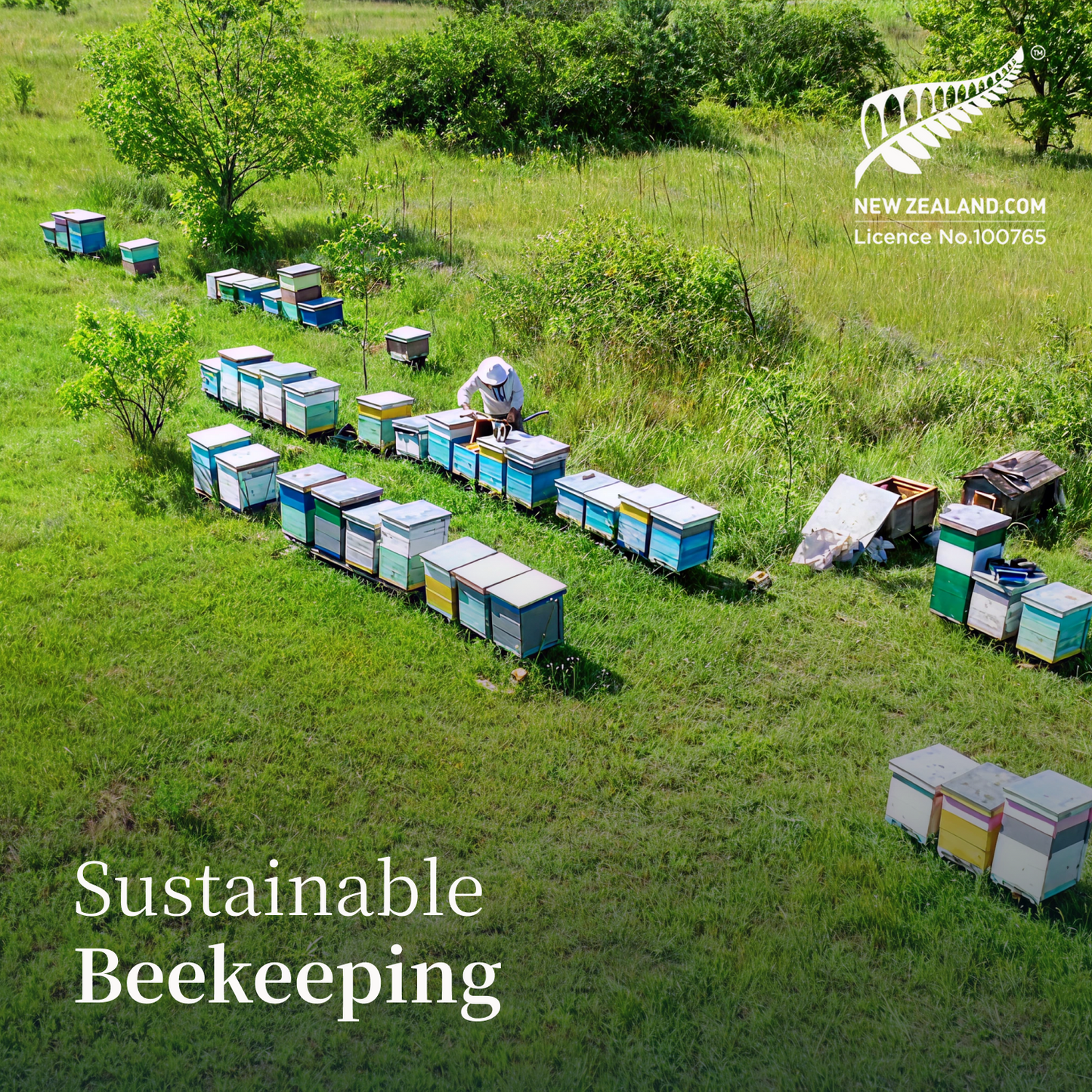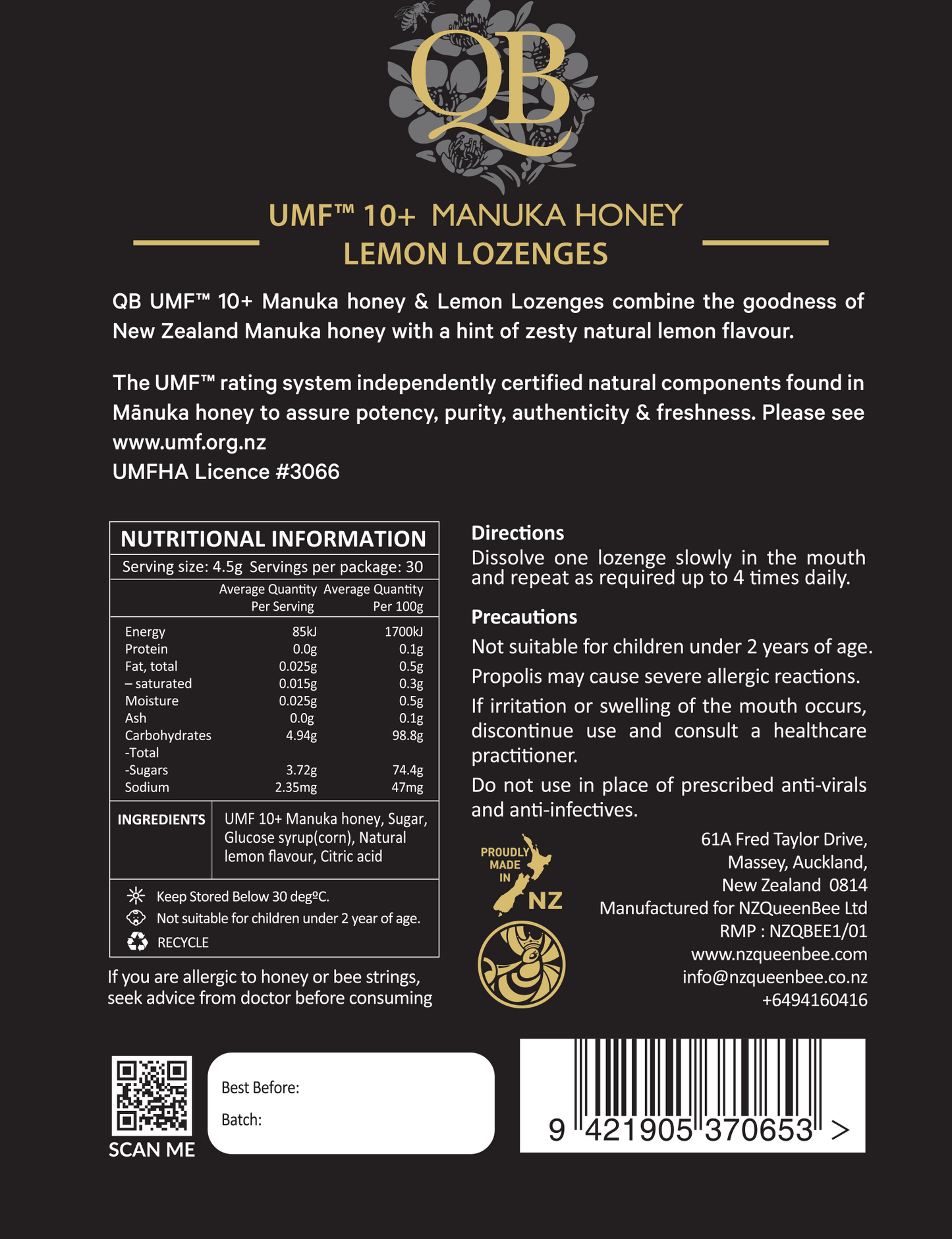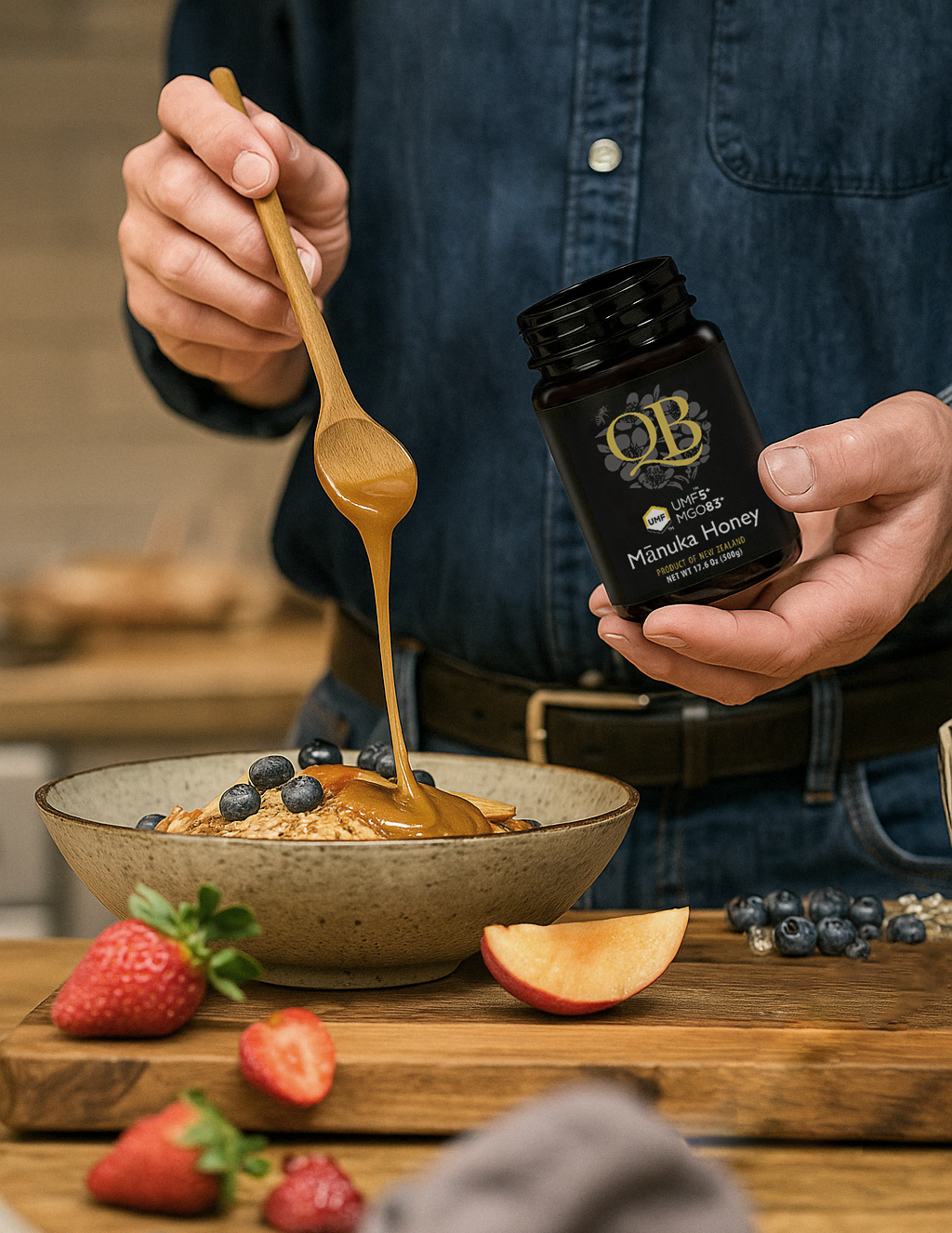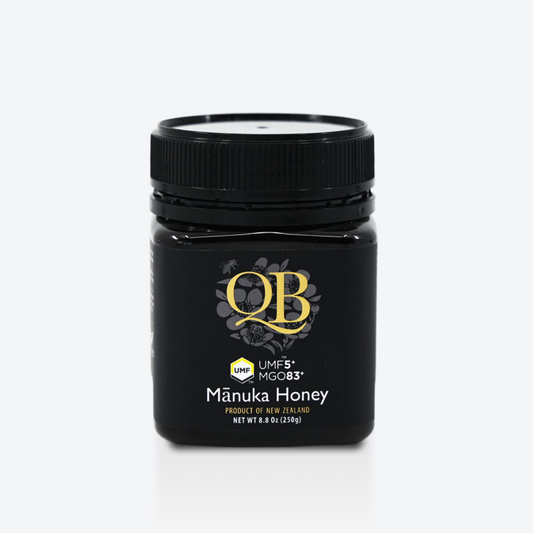QB Manuka Honey Lemon Lozenges Box 54g
QB Manuka Honey Lemon Lozenges Box 54g
Couldn't load pickup availability
Daily Wellness
Throat Soothing
Usage
Usage
These lozenges are perfect for soothing a dry, scratchy, or sore throat and helping to calm coughs. Simply place one lozenge in your mouth and allow it to dissolve slowly. Do not chew or swallow it whole, as allowing it to dissolve gradually maximizes its soothing effect. They are convenient to carry and can be used anytime, anywhere you need throat comfort. Take as needed throughout the day.
Precautions
• Not suitable for children under 2 years of age.
• Propolis may cause severe allergic reactions.
• If irritation or swelling of the mouth occurs, discontinue use and consult a healthcare practitioner.
• Do not use in place of prescribed anti-virals and anti-infectives.
Taste
Taste
Experience a delightful fusion of flavors. The natural, distinct sweetness of Manuka honey is beautifully balanced with the bright, refreshing tang of lemon. It's a classic combination that offers a soothing yet invigorating taste experience. The sweetness is comforting, while the citrus adds a pleasant zest, creating a balanced profile that is both delicious and beneficial for the throat.
Ingredients
Ingredients
UMF 10+ Manuka Honey, Sugar, Glucose syrup(corn), Natural lemon flavour, Citric acid
Biodiversity
Biodiversity
Our Manuka honey is harvested from remote, untouched regions across New Zealand’s North Island, where native Manuka bushes flourish naturally. These pristine environments support rich biodiversity, providing ideal conditions for bees to produce honey of exceptional purity and potency.
We place our hives in hard-to-reach, uncultivated landscapes, some only accessible by helicopter, to ensure that our bees forage exclusively from Manuka blossoms. This not only results in high-quality, monofloral honey—but also protects the surrounding ecosystems.
Our commitment to biodiversity means:
• No synthetic chemicals or antibiotics in our beekeeping.
• Respectful harvesting practices that protect native flora and fauna.
• A deep partnership with nature and the land, inspired by Māori values.
Each jar of QB Manuka honey reflects a thriving, balanced ecosystem—delivered from hive to your hands with care and sustainability at its core.
Nutritional Information
Nutritional Information
Per 4.5g serving
• Energy: 85 kJ
• Protein: Less than 1 g
• Fat, total: Less than 1g
– Saturated Fat: Less than 1g
• Carbohydrates: 4.94 g
– Total Sugars: 3.72mg• Sodium: 2.35 mg






From Hive to Jar, From Land to You
Rich, smooth, and slightly earthy, Manuka honey melts on the tongue with a deep sweetness that brings instant comfort.
But it offers more than just taste. Naturally high in MGO, it helps support your immune system, soothes the throat, and nourishes the body from within.
Stir it into tea, drizzle it on toast, blend it into smoothies, or enjoy it by the spoonful. Because something so simple should still feel this good.
Great for winter. Pops one in before meetings and my voice holds up all day.
Good to keep on hand. Soothes fast and doesn’t taste synthetic. Bonus points for the lemon.
FAQs
What is the difference between Manuka honey and normal honey?
The primary differences between Manuka honey and "regular" honey (which typically refers to multifloral honey or common monofloral honeys like clover, wildflower, acacia, etc.) lie in their floral source, unique chemical composition, antibacterial properties, taste, texture, and price.
Here's a breakdown of the key differences:
Floral Source:
Manuka Honey
• Produced by bees that pollinate the Leptospermum scoparium (Manuka) bush, native to New Zealand.
Regular Honey
• Can come from a vast array of flowering plants, leading to a wide variety of flavors, colors, and properties.
Unique Chemical Composition & Antibacterial Properties:
Manuka Honey
• Methylglyoxal (MGO): This is the star compound. Manuka honey contains significantly higher levels of MGO than other honeys. MGO is directly responsible for Manuka's potent, stable, non-peroxide antibacterial activity (NPA). The higher the MGO level (or UMF rating, which is correlated with MGO), the stronger its antibacterial effect.
• Dihydroxyacetone (DHA): Found in the nectar of Manuka flowers, DHA converts into MGO in the honey over time.
• Leptosperin: A naturally occurring chemical found only in Manuka nectar, used as an authenticity marker.
• Its antibacterial action is less affected by heat or dilution compared to the peroxide activity in other honeys.
Regular Honey
• Most honeys exhibit antibacterial properties primarily due to hydrogen peroxide, which is produced by an enzyme (glucose oxidase) introduced by bees. This activity is known as peroxide activity (PA).
• Hydrogen peroxide is less stable than MGO and can be degraded by heat, light, and the catalase enzyme present in bodily fluids (like saliva or wound exudate).
• Regular honeys also have low pH and high sugar content, which contribute to their antimicrobial effects by creating an inhospitable environment for microbes.
Taste and Aroma:
Manuka Honey
• Has a distinctive, strong, somewhat earthy, mineral-like, or medicinal flavor, often with a slightly bitter undertone. It's generally less sweet than many other honeys.
Regular Honey
• Varies greatly depending on the floral source. Can be mild, floral, fruity, caramel-like, herbaceous, etc.
Texture and Appearance:
Manuka Honey
• Often darker and more viscous (thicker) than many other honeys. It can be thixotropic, meaning it becomes gel-like when still and more liquid when stirred.
Regular Honey
• Wide range of colors (from nearly clear to dark brown) and textures (from very runny to densely crystalline).
Therapeutic Uses & Research:
Manuka Honey
• Extensively researched for its medicinal properties, particularly in wound healing (medical-grade Manuka honey is used in hospitals), soothing sore throats, and potentially aiding digestive health. Its stable NPA makes it more reliable for therapeutic applications.
Regular Honey
• Has been used traditionally for similar purposes and does have benefits, but the specific antibacterial strength and consistency are generally lower and less predictable than high-grade Manuka.
Price:
Manuka Honey
• Significantly more expensive. This is due to its limited geographical production area, unique properties, the cost of testing and certification (MGO, UMF ratings), and high demand.
Regular Honey
• Generally much more affordable.
Grading and Certification:
Manuka Honey
• Often sold with specific grading systems like UMF (Unique Manuka Factor) or direct MGO ratings to indicate its potency. New Zealand has strict government regulations for Manuka honey export to ensure authenticity.
Regular Honey
• Typically not graded for specific bioactive compounds, though there are quality standards for purity, moisture content, etc.
What does UMF™ mean, and how do I choose the right one?
UMF™ (Unique Manuka Factor) is a quality trademark and grading system that guarantees the purity, potency, and authenticity of Manuka honey produced in New Zealand. It is managed by the UMF Honey Association (UMFHA) in New Zealand.
When you see the UMF™ trademark on a jar of Manuka honey, It's Genuine Manuka Honey
The honey has been produced from the nectar of the Leptospermum scoparium (Manuka) bush native to New Zealand.
It's Tested for Key Signature Markers
The honey has been independently tested in accredited laboratories for specific chemical markers that are naturally present in Manuka honey:
• Leptosperin: A natural chemical found only in the nectar of Manuka flowers. It's a key indicator of authenticity.
• DHA (Dihydroxyacetone): A compound found in Manuka nectar that converts into MGO in the honey over time.
• MGO (Methylglyoxal): The key compound directly responsible for Manuka honey's unique, stable non-peroxide antibacterial activity. This is the primary driver of the UMF™ rating.
• HMF (Hydroxymethylfurfural): This is also checked to ensure the honey has not been overheated or stored improperly, as high HMF can indicate damage or adulteration. The UMFHA has limits for this.
The Number Relates to Potency
The number following UMF™ (e.g., UMF™ 5+, UMF™ 10+, UMF™ 15+, UMF™ 20+) indicates the level of the unique non-peroxide antibacterial activity. The higher the UMF™ number, the higher the concentration of these signature compounds (especially MGO) and therefore the stronger its antibacterial properties. The UMF™ value is benchmarked against the antibacterial effect of a standard antiseptic (phenol). For example, UMF™ 10+ has the equivalent antibacterial strength of a 10% phenol solution under lab conditions.
It's Packed and Labeled in New Zealand
To carry the UMF™ mark, the honey must be packed and labeled in New Zealand by a UMFHA licensed company.
Audited and Traceable
UMFHA members are regularly audited to ensure they meet stringent quality standards.
How to Choose the Right UMF™ Level
Choosing the right UMF™ level depends on your intended use and budget, as higher UMF™ ratings come with a higher price tag.
UMF™ 5+ to UMF™ 9+ (Low Strength / Maintenance Level)
• Use: General daily health and wellness, as a natural sweetener, for mild immune support, or simply for its unique taste.
• MGO Equivalent: Approximately 83+ to 262+ mg/kg.
• Consideration: Good for everyday consumption and as an entry-level Manuka honey.
UMF™ 10+ to UMF™ 14+ (Medium Strength / Therapeutic Start)
• Use: Good for more targeted therapeutic benefits, such as soothing sore throats, supporting digestive health, or for minor topical applications (though for open wounds, medical-grade Manuka is best).
• MGO Equivalent: Approximately 263+ to 485+ mg/kg.
• Consideration: A popular choice for noticeable therapeutic effects without the highest price tag. Many consider UMF™ 10+ the minimum for therapeutic use.
UMF™ 15+ to UMF™ 19+ (High Strength / Strong Therapeutic Use)
• Use: For stronger therapeutic support, more significant digestive issues, boosting the immune system when feeling run down, or more potent topical applications.
• MGO Equivalent: Approximately 514+ to 778+ mg/kg.
• Consideration: Offers potent benefits and is often chosen by those seeking significant therapeutic effects.
UMF™ 20+ and Above (Very High Strength / Potent Therapeutic Use)
• Use: Highest levels of therapeutic activity. Often used for specific, more serious conditions (always consult a healthcare professional for medical advice), stubborn digestive issues, or when maximum potency is desired.
• MGO Equivalent: Approximately 829+ mg/kg and higher.
• Consideration: This is the most potent and most expensive Manuka honey. The taste can be quite strong and "medicinal."
Key Considerations When Choosing
• Purpose: Are you using it as a daily sweetener or for a specific health concern?
• Budget: Higher UMF™ levels are significantly more expensive.
• Taste: Higher UMF™ Manuka honey tends to have a stronger, more intense, and sometimes more medicinal flavor.
• Authenticity: Always look for the official UMF™ trademark and the company's UMF™ license number on the label. You can often verify the license number on the UMFHA website.
Important Note
While Manuka honey has recognized health benefits, it is not a substitute for medical treatment. If you have a serious health condition, always consult your doctor.
What does MGO mean, and why does it matter?
MGO (Methylglyoxal) is the natural compound that gives Manuka honey its antibacterial power. It helps fight off illness, support healing, and protect the body from within and on the skin. Here’s how MGO levels relate to real-life benefits:
ㅤ- MGO 263+ (UMF 10+): Daily energy, gut balance, gentle support
ㅤ- MGO 514+ to 829+ (UMF 15+ to 20+): Better digestion, immunity, sore throat relief
ㅤ- MGO 1122+ and above (UMF 24+): Stronger wound care, skin recovery, deeper immune support
Higher MGO means more potent effects, especially for topical use or more serious wellness needs.
Why is Manuka Honey more expensive than other honeys?
Manuka honey is significantly more expensive than other types of honey due to a combination of factors related to its unique properties, limited production, and high demand.
Limited Geographical Source
True Manuka honey comes from bees that pollinate the Leptospermum scoparium (Manuka) bush, which is native to New Zealand and some parts of Australia. This restricted geographical origin naturally limits supply.
Short Flowering Season & Remote Locations
The Manuka bush has a very short flowering season, typically only 2–6 weeks per year. This narrow window means bees have limited time to collect the nectar.
Many Manuka bushes grow in wild, remote, and often rugged terrain, making it difficult and costly for beekeepers to access these areas with their hives, sometimes even requiring helicopter transport.
Unique Bioactive Compounds & Testing
Manuka honey contains unique natural compounds, most notably Methylglyoxal (MGO), which is responsible for its potent and stable non-peroxide antibacterial activity. Other markers like Leptosperin and DHA confirm its authenticity.
To guarantee authenticity and potency, Manuka honey undergoes rigorous laboratory testing for these specific markers. This testing and certification (e.g., UMF™, MGO ratings) add significant cost.
Certification and Regulation
New Zealand has strict regulations and standards, such as those from the Ministry for Primary Industries (MPI) and the UMF Honey Association to define and protect genuine Manuka honey.
Compliance with these standards, along with licensing and auditing, adds to the overall production cost.
Lower Yields & Variable Harvests
The nectar flow from Manuka flowers can be highly variable and dependent on weather conditions during the short flowering season. As a result, honey yields per hive can be lower and less predictable compared to more common floral sources.
High Global Demand
Due to its well-researched and widely publicized health benefits, especially its antibacterial and wound-healing properties, there is very high global demand for genuine, high-grade Manuka honey.
When demand is high and supply is limited, prices naturally rise.
Specialized Beekeeping Practices
Beekeepers often need to use specialized hive management techniques and logistics to maximize the collection of Manuka nectar while minimizing contamination from other floral sources.
This adds complexity and cost to the production process.
Research and Marketing
Significant investment has gone into researching the health properties of Manuka honey and promoting it globally. These costs are included in the final retail price.
In Summary
You’re paying for a product that is rare, difficult to produce consistently, requires expensive testing and certification to verify its unique beneficial properties, and is in high demand globally.
Is anything added to NZ Queen Bee Manuka honey?
Nothing is added, ever.
Our honey is 100 percent pure, raw, and unprocessed to keep its natural MGO, enzymes, and healing properties intact.
There are no preservatives, sweeteners, or additives. Just real honey made to care for you.
How can Manuka Honey be used?
Manuka honey is versatile and can be used in various ways, both internally and topically, thanks to its unique antibacterial, anti-inflammatory, and antioxidant properties. The UMF™ or MGO rating often guides its application, with higher ratings typically reserved for more therapeutic uses.
Internal Use (Health and Wellness)
Soothing Sore Throats and Coughs
• Take 1 to 2 teaspoons straight from the jar to coat the throat.
• Mix into warm (not boiling) water with lemon to preserve beneficial compounds.
• Higher UMF™ or MGO (such as 10+ or above) is often preferred for this use.
Supporting Digestive Health
• Some people take a teaspoon daily on an empty stomach or before meals to soothe the digestive tract.
• It may help with acid reflux, bloating, or support a healthy gut microbiome.
• Manuka honey has been studied for its potential effects against H. pylori (a bacterium linked to stomach ulcers) and for managing symptoms of SIBO (Small Intestinal Bacterial Overgrowth). More research is needed, and it should be used as part of a broader plan, not as a standalone cure.
Boosting General Immunity
• Regular consumption of Manuka honey, such as UMF™ 5+ or 10+, may contribute to overall wellness due to its antioxidant and antimicrobial properties.
Improving Oral Health
• Its antibacterial qualities may help reduce plaque and soothe gum inflammation.
• Some use it diluted as a mouth rinse or apply a small amount directly to the gums.
As a Natural Sweetener
• Use in tea, coffee (once it's drinkable), smoothies, yogurt, oatmeal, or spread on toast.
• It is a healthier alternative to refined sugar but should still be consumed in moderation.
Topical Use (Skin and Wound Care)
Wound Healing
• For minor cuts, burns, abrasions, and ulcers, apply a thin layer of high UMF™ or MGO Manuka honey (often UMF™ 15+ or medical-grade) directly to the cleaned wound and cover with a sterile dressing.
• Its antibacterial properties help prevent infection, reduce inflammation, and support moist wound healing.
Important: For serious wounds, deep burns, or infections, consult a healthcare professional. Medical-grade Manuka honey is sterilized and specially prepared for clinical use.
Skincare
• Face Mask: Apply a thin layer to clean skin, leave for 15 to 20 minutes, then rinse off. Helps hydrate and calm inflammation.
• Spot Treatment for Acne: Dab a small amount directly on blemishes.
• Soothing Skin Irritations: May help calm minor rashes, eczema flare-ups, or insect bites.
Lip Care
• Apply to dry or chapped lips for moisture and healing.
Culinary Use
Flavor Enhancer
• Its rich, complex flavor can add depth to marinades, salad dressings, glazes, and baked goods.
Note: Extensive heating can reduce the honey’s beneficial properties.
In Smoothies and Drinks
• Adds natural sweetness and a unique flavor profile when blended into beverages.
Important Considerations When Using Manuka Honey
• UMF™ or MGO Rating: Choose a level that fits your purpose. Lower grades (such as UMF™ 5+) are suited for general wellness and food use. Higher grades (UMF™ 10+ and above) are best for therapeutic applications.
• Heat Sensitivity: Avoid adding to boiling water. High temperatures can degrade enzymes and reduce MGO content. Use in warm, not hot, beverages.
• Infants: Do not give honey to children under 12 months of age due to the risk of infant botulism.
• Allergies: Though rare, some individuals may be allergic to honey or other bee products.
• Diabetes: Manuka honey is still sugar. People with diabetes should monitor their intake and consult their doctor.
• Authenticity: Buy from reputable brands that clearly display UMF™ or MGO ratings.
• Medical Advice: Manuka honey can be a powerful natural remedy, but it is not a substitute for professional medical care. Always consult a doctor for serious health concerns.
In Summary
Manuka honey offers a wide range of uses across health, wellness, skincare, and culinary applications. By understanding the strengths and how to use them correctly, you can make the most of this remarkable natural product.
How long does Manuka honey last?
Manuka honey, like all pure honey, has an incredibly long shelf life and does not truly expire or go bad if stored properly. You will often see a "Best Before" or "Best By" date on the jar, but this is simply a guide to optimal quality. It refers to aspects like flavor, texture, and guaranteed MGO or UMF™ potency rather than a strict safety cutoff.
Natural Preservative Qualities
Several natural factors make Manuka honey highly resistant to spoilage:
• Low Water Content: Typically below 18 to 20 percent, which helps prevent the growth of yeast and bacteria.
• High Sugar Concentration: Creates an environment that draws moisture out of microorganisms, effectively killing them.
• Acidic pH: Naturally acidic, usually between 3.2 and 4.5, which discourages microbial growth.
• Enzymes: Bees add glucose oxidase, which produces hydrogen peroxide when honey is diluted.
• Methylglyoxal (MGO): Found in Manuka honey, MGO provides strong and stable antibacterial activity that helps preserve the honey.
What the "Best Before" Date Means
• Manufacturers usually print a "Best Before" date that ranges from 2 to 5 years after the honey is packed.
• This date indicates the period during which the honey is expected to maintain its labeled UMF™ or MGO potency, as well as its ideal flavor and texture.
• The honey remains safe to consume even after this date.
How Manuka Honey Changes Over Time
• Crystallization: Over time, honey may solidify or become grainy. This is normal and does not mean the honey has spoiled. You can gently warm the jar in a bowl of warm water to return it to a liquid state.
• Darkening: The honey may darken with age, especially if exposed to light or heat. This affects appearance but not safety.
• Flavor Changes: The taste may become more mellow or develop a deeper flavor over time.
• MGO Levels: MGO levels may increase for a while after harvest as DHA (Dihydroxyacetone) naturally converts to MGO. After long periods or if stored improperly, MGO levels may slowly decline, but the honey will still be safe to eat.
Proper Storage for Longevity
• Keep the honey in an airtight container, ideally the original jar.
• Store it in a cool, dark place away from sunlight and heat sources such as ovens or stovetops.
• Always use a clean, dry spoon. Introducing moisture can cause fermentation if enough water is added.
In Summary
When stored correctly, Manuka honey remains safe to eat for many years. The "Best Before" date simply marks the period during which the producer guarantees the honey's therapeutic strength and best quality. Even after this date, the honey is still edible, although some of its active properties may gradually change over time.
Is Manuka honey safe for children?
Yes, Manuka honey is generally safe for children, but there is one critical exception and several important considerations to keep in mind.
The Critical Exception: Infants Under 12 Months
• Do not give Manuka honey, or any type of honey, to infants under 12 months of age.
• The reason is that honey can contain spores of a bacterium called Clostridium botulinum. In an infant’s immature digestive system, these spores can germinate and produce a toxin that causes infant botulism.
• This is a rare but serious illness that may lead to muscle weakness, difficulty breathing, and in some cases, life-threatening complications.
• Older children and adults have mature digestive systems that can neutralize these spores safely.
For Children Over 12 Months of Age
• Manuka honey is generally considered safe for children over one year old. It may provide several health and wellness benefits when used appropriately.
Soothing Sore Throats and Coughs
• A small teaspoon of Manuka honey can help coat the throat and calm coughing.
• Its natural antibacterial properties may also help fight off mild throat infections.
• Many parents consider it a safer, more natural alternative to over-the-counter cough medicines, which are often not recommended for young children.
Wound Healing (Topical Use)
• For minor cuts, scrapes, or burns (after cooling), applying a thin layer of Manuka honey may help keep the area clean and support healing.
• Its antibacterial action creates a barrier that protects the wound.
• Always clean the wound before applying honey. For more serious injuries, consult a healthcare professional.
General Immune Support
• Some natural compounds in Manuka honey may offer light immune support for children, particularly when used as part of a balanced diet.
As a Natural Sweetener
• Manuka honey can be used in small amounts as a healthier alternative to refined sugar.
• It works well in oatmeal, yogurt, or warm (not hot) drinks. Like all sweeteners, it should be used in moderation.
Important Considerations for Children Over 12 Months
• Moderation is Key: Honey is still a sugar and should be limited to small amounts, such as half to one teaspoon per serving. Overconsumption may contribute to tooth decay or unnecessary calories.
• Allergies: Although rare, allergies to honey or bee products can happen. If your child has a known bee allergy, be cautious. If unsure, introduce a very small amount first and observe for any reactions.
• Dental Health: Like other sugary foods, honey can impact teeth. Encourage tooth brushing, especially if honey is consumed before bedtime.
• UMF™ or MGO Strength: For general use in children, lower to mid-range ratings such as UMF™ 5+ to 10+ are typically enough. Higher grades are usually unnecessary and more expensive.
• Consult a Pediatrician: If your child has a health condition or you plan to use Manuka honey for a therapeutic purpose, it is best to speak with their doctor or pediatrician first.
In Summary
Do not give any honey to babies under 12 months.
For children older than one year, Manuka honey is generally safe and can be helpful in small amounts.
It may soothe coughs, support healing of minor wounds, and serve as a natural sweetener.
Always maintain good dental hygiene and consult a doctor for serious concerns or health conditions.
How do I know if my Manuka honey is real?
Ensuring your Manuka honey is genuine is important due to its premium price and unique health properties. Here's a clear guide to help you verify authenticity.
Look for the UMF™ Trademark (Most Reliable for New Zealand Manuka)
• The UMF™ Mark: Stands for Unique Manuka Factor and is a trademark from the UMF Honey Association (UMFHA) in New Zealand. It is one of the most reliable indicators of genuine Manuka honey.
• License Number: The product label should show the UMF™ licensee's name and license number. You can verify the license number on the official UMFHA website (www.umf.org.nz).
• Rating: The label will include a UMF™ rating such as UMF™ 5+, 10+, 15+, or 20+.
• Packed in New Zealand: To carry the UMF™ mark, the honey must be packed and labeled in New Zealand.
• Tested for Key Markers: UMF™ certified honey is tested for Leptosperin, DHA (Dihydroxyacetone), and MGO (Methylglyoxal).
Check for MGO (Methylglyoxal) Rating
• MGO is the main compound responsible for Manuka honey’s antibacterial strength.
• Reputable brands will clearly state the MGO content in mg/kg, such as MGO 100+, MGO 250+, or MGO 550+.
• Higher MGO numbers indicate greater antibacterial potency.
• Be aware that MGO can be synthetically added. This is why certification systems like UMF™, which test multiple natural markers, are more trustworthy.
Look for “Packed in New Zealand”
• Authentic New Zealand Manuka honey will clearly state "Packed in New Zealand" or "Product of New Zealand."
• New Zealand’s Ministry for Primary Industries (MPI) requires testing for both chemical and DNA markers to confirm authenticity before honey can be exported.
• Products that claim to be New Zealand Manuka but are packed elsewhere should be viewed with caution.
Check Brand Reputation and Traceability
• Buy from well-known brands that are transparent about their sourcing and testing.
• Some brands offer batch tracking systems where you can enter a code online and see the lab results for your specific jar.
• Transparency and traceability are signs of quality.
Watch the Price
• Real Manuka honey is expensive to produce and test.
• A very low price compared to trusted brands may be a warning sign of dilution, poor quality, or counterfeit products.
Read Labeling Details Carefully
• The label should look professional and provide detailed information.
• Avoid vague terms like "Manuka Blend," "Active Manuka," or just "Manuka" without a clear UMF™ or MGO rating and without a declared New Zealand origin.
• Phrases like "Active X+" without UMF™ or MGO references are often marketing terms with no verified standard.
• Labels should clearly include the grading system, origin, and license details.
Assess the Consistency and Taste (Subjective Checks)
• Genuine Manuka honey tends to be thicker and darker than regular honey.
• The taste is usually earthy or medicinal, with a mineral-like flavor and slightly bitter aftertaste.
• These qualities vary by batch and are helpful, but they are not reliable for confirming authenticity without certification.
Buy from Reputable Retailers
• Purchase from trusted health food stores, pharmacies, or official brand websites.
• Be cautious when buying from online marketplaces where counterfeits may occasionally appear.
What to Be Wary Of
• No UMF™ or MGO rating listed.
• Terms like "Active," "Bio-Active," or "Factor" without standardized values.
• Prices that are too good to be true.
• Honey claiming to be from New Zealand but not packed there.
• Labels that are vague or missing brand contact information.
In Summary
To ensure your Manuka honey is real, always check for the UMF™ trademark and verify the license number. Look for a clear MGO rating, make sure it is packed in New Zealand (if it claims to be New Zealand Manuka), and buy only from reputable brands and retailers. These simple steps can help you avoid counterfeits and enjoy the full benefits of genuine Manuka honey.










